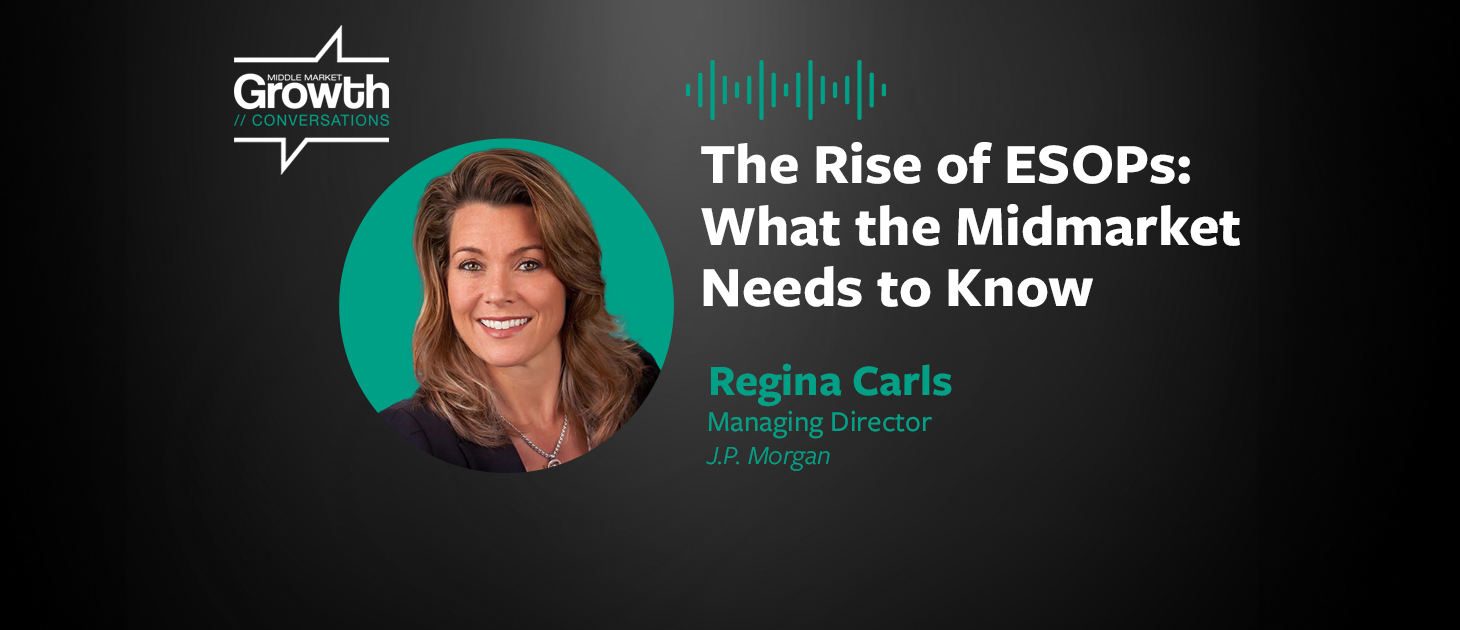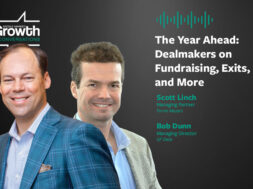The Rise of ESOPs: What the Midmarket Needs to Know
Regina Carls of J.P. Morgan shares what midmarket businesses and their sponsors need to know about ESOPs

Employee stock ownerships plans (ESOPs) are experiencing a surge in popularity due to tax policy, cultural benefits, and their flexibility as a corporate finance tool. Regina Carls, managing director at J.P. Morgan and the leader of its ESOPs advisory group, sits down with the podcast to dispel common myths about ESOPs, discuss their benefits, and give actionable advice to those considering an ESOP structure, whether they be middle-market companies or their sponsors.
This episode is brought to you by GF Data, a provider of reliable, confidential data on private equity-sponsored M&A transactions in the $10 million–$500 million enterprise value range. GF Data’s proprietary data is sourced directly from private equity groups and used by ESOP advisors, valuation firms, lenders, investors, and M&A advisors for benchmarking, valuation, and market analysis. Learn more at gfdata.com/ESOPs.
Read a transcript of the podcast below.
Middle Market Growth: Welcome to Middle Market Growth Conversations, a podcast for dealmakers discussing the trends shaping the middle market. I’m your host, Carolyn Vallejo, and this is a production of the Association for Corporate Growth. Today we’re joined by Regina Carls, managing director at J.P. Morgan, and the founder and leader of their ESOPs advisory group. She’s here to talk about the rise of employee stock ownership plans and what makes them attractive to dealmakers and firm owners, plus some key considerations for those who are considering implementing them. Regina, welcome to the podcast.
Regina Carls: Thank you for having me.
MMG: We are very glad you’re here. Now we like to spend a little time here at the beginning getting to know you a little bit better. Can you start by telling us a bit about yourself and your work at J.P. Morgan?
RC: Sure. I’ve been with the firm now for 33 years. I started off in our loan officer training program right out of college and then ultimately rose to running a division of lenders before being tapped to start up the ESOP group 18 years ago. Our team’s a national team that partners with our bankers across the country to educate both them and their clients and prospects about ESOPs run modeling to show them how an ESOP can be financed, as well as dealing with growth and M&A with our ESOP companies. So we are involved from inception of the transaction through the life of the ESOP with our clients.
MMG: And just for fun, what was your first job and what was a lifelong lesson that you took away from it?
RC: My first job coming from a far suburb in Chicago, was as a corn de-tasseler because it was one of the jobs that kids could get at a very young age. I think all the parents pushed us into this to make us understand the value of a day’s work long hours of manual labor in the hot sun. And so from that I would say we all learned the importance of education for a future job as well as, you know, really hard work, you get out of it what you put into it and that hard work does pay off.
MMG: Hard work does pay off. That is a great lesson. Now, to get to our main theme today, we are sitting down to talk in October. This is actually employee ownership month, and, you know, ESOPs, which stands for Employee Stock Ownership Plans, have had this recent rise in interest and popularity as a generation of business owners are eyeing retirement. So, could you kick us off by giving us a quick overview of what an ESOP actually is?
RC: Sure. So, there are both public company ESOPs and private company ESOPs. You know, public companies tend to use them just as an additional incentive, additional qualified plan and they tend to be very small, 5 to 10%. I’d kind of say a focus on the private company side as it’s a way for business owners to really transition their ownership and receive liquidity by selling their stock to employees versus a third party sale to a third party company. Additionally, you know, big picture, I’ll say they’re tax qualified employee benefit plans, so it’s similar to a 401k plan, and they’re also governed by the same laws of the Internal Revenue Code and ERISA. So, you know, when you look at 401k plans, the most common features are, you know, contributions are tax deductible. The earnings in the plan accrue tax free, and the employees don’t pay current tax. Two primary differences within ESOPs, however, is that they are required to be primarily invested in company stock, which is over 50%. This is different from a 401k, which requires diversification, and then that they’re permitted to borrow, which in other qualified plans would be a prohibited transaction. It’s really these two additional features that make ESOPs a corp finance tool that we’re able to use those to, you know, sell the business and transition the ownership. The other thing is, you know, owners can sell any amount to an ESOP from one to a hundred percent, which has really been great flexibility for sellers who maybe want to dip their toe in, sell a little bit of it, you know, to understand how these work, and then maybe go to a hundred percent over time. It also allows sellers to sell their business, but also still stay involved in the business. So really a flexible tool that business owners can customize to fit the needs of the business.
MMG: Are there any common misconceptions about ESOPs that maybe creep up when you talk to business owners or middle-market investors?
RC: Yes. I would say over time these misconceptions are reducing, but I would say some of them that we continue to hear, one being that they don’t pay fair market value, and this is incorrect, you know, they’re similar to a financial buyer, like a private equity. They can’t pay strategic value, which is when you’re selling to another competitor, let’s say they can pay a higher multiple just because there’s synergies or cost savings that can be realized due to the headcount reduction or facility reduction. But they do pay fair market value like a financial buyer. Another one I would say is that, you know, selling to an ESOP precludes a company from a future sale. Given the fact that these deals are trading all the time, we put on about 250 new transactions a year. At the same time, about 250 are selling or merging. We certainly see a lot of trading going on and activity. So that dispels that myth. Another one that comes up is related to governance and, you know, the fact that there’s a trustee that’s involved in an ESOP transaction, they’ll say that an ESOP trustee may make it difficult to transact or preclude a future sale. I think from my prior point, I’ve just highlighted the fact that these deals trade all the time. It is true that there is a third party trustee because the trust is the legal shareholder and the employee participants just have a beneficial interest in the trust. And the trustee, though, is responsible for making sure that the plan is operated in the best interest of plan participants and protect from abuses. So, it is not stepping into running the company. They don’t sit on the board, they’re just there as an oversight and make sure that they’re protecting shareholders, which are the employee participants. And then I’d say the final one would be that ESOPs replace existing benefit plans and/or compensation. I think this is a misnomer just from transactions from long time ago where there may be wage concessions that were taken when ESOPs were put in place. That is not how the current structures work. The vast majority of these ESOPs are incremental to existing wages benefits, and most of them actually maintain an existing 401k plan when they put an ESOP in place, and so allows the employees to invest in diversified investments. And then their company contribution that was once going into the 401k is now redirected into ESOP in the form of a stock contribution. So they actually are very lucrative when compared to many plans.
MMG: Now, I understand that one of the factors making ESOPs so popular right now is tax policy. You already touched on a bit of some of the tax benefits, but could you give us a deeper dive into what other tax advantages ESOPs have?
RC: Sure. So, ESOPs have been around since the early 70s and they started off as C corp ESOPs. So as a qualified plan, which I’d stated before, you know, companies can contribute about 25% of covered comp to a qualified plan each year. So in addition, C corp ESOPs have an added benefit where their dividends are also deductible. This is not something that’s permitted outside of ESOPs. So both contributions and dividends reduce taxable income in an ESOP C corp structure. From a shareholder perspective and a selling shareholder perspective, C corp ESOPs have an additional benefit whereby the selling shareholder, if they sell a minimum of 30% to a C corp ESOP, and they take those proceeds and redirect them into qualified replacement securities, which are stocks and bonds of domestic operating companies, the selling shareholder can defer cap gains. And if that shareholder dies without selling those 10 42, there’s a full step up in basis. So it can be a complete elimination of capital gains. On the S corp side, S corp legislation didn’t pass until 1998. As an S corporation, that’s a pass through entity and an ESOP is a tax exempt trust. So if the company is a hundred percent S-corp ESOP owned, the company pays no federal income tax and in many states no state income tax. And so those savings are retained in the business and typically use to de-leverage the transaction, which is why 100% S corp ESOPs have been so popular. We do also see some legislation right now for S corporations. We’re trying to get that 10 42 benefit to the S corporation. Today there’s a very low benefit that’s being put in but over time we’re expecting to hopefully have legislation passed that would allow that same 10 42 to S corporations. As a result, today, if you’re an S corporation and you want to get the 10 42 capital gain deferral, a selling shareholder will have to convert to a C corporation, take 10 42, and then hold that structure five years before converting back to an S. So it’s a little bit more involved if you want to do a capital gain deferral, but we do see a lot of companies who do that.
MMG: What are some of the other factors behind the rise of ESOPs? What are the other benefits of this ownership structure?
RC: Sure. I think, you know, by and large, taxes drive a lot of the initial interest, but I think, you know, more and more we’re seeing more employee owners or employees owners are getting a bigger voice in companies and employers want to give back to those employees that have really driven the value of the business over time. Where we find a very consistent theme is owners who really want that legacy. They may have been a very large employer in town. They’re giving a lot to their community and they want to see this continue. I think another big piece of it is there’s a lot of studies now that are showing employee ownership has really driven improved company performance. And so employers are not only, you know, what I think from a benefit perspective like a 401K, we typically only receive a statement that shows the value. That’s all that’s required for ESOP to provide, but we’re finding companies who really drive engagement are those that really show how value is driven in the company, so much as showing them how valuation is driven. And employees can see how the work they’re doing can actually impact the value of the company stock. By virtue of that they’ll see, you know, stock value growing each year, they’re going to understand how their work performance can actually drive stock performance. And I think there’s just generally more awareness in the structure today given the increasing number of practitioners that are participating in the space.
MMG: It sounds like employees and owners are seeing a lot of positives in ESOPs. When it comes to private equity firms and other middle-market investors, are you seeing any interesting ways that they’re using ESOPs?
RC: So I think we’ve always seen private equity play in the space. However, they historically would only look to divest of a portfolio company to an ESOP if they can’t sell it to a third party, a strategic, and so in those situations they tend to be more limited involvement. Over time, given the number of private equity players in the space as well as I think the number of ESOP companies of size, private equity are beginning to look to ways that they can participate in this structure. And so we’re seeing more of them co-investing in these deals going into an ESOP formation as well as, I think predominantly, being seen used in mature ESOPs, to either fund M&A or funding redemption obligations, as well as providing growth capital. So for example, we had a mature hundred percent ESOP company that needed capital to fund their redemption obligations as well as fund some strategic growth initiatives. This private equity came in and took the ESOP down from a hundred percent to 30% to really facilitate the transaction. So rather than, you know, eliminating the ESOP altogether, many of these companies have a very strong culture. And so keeping some level of ESOP ownership for the employees really led to that one plus one equals three outcome. Also, you know, private equity structures typically have involved structured equity, which is where you’re incorporating subordinate debt with warrants, as well as direct equity through the use of a dropdown analysis structure. So that’s become pretty commonplace to see private equity looking to directly invest in these. And then we’ve also seen family offices that are interested and, you know, want to really be long-term permanent capital in these deals, given the tax benefits and the performance metrics that they’ve shown through various cycles.
MMG: Okay, so a lot of potential investor interest from the middle market. Are there any industries or sectors where ESOPs are more popular or that are more suited for ESOPs?
RC: Well, I mean, I think as a qualified plan, any company can set up an ESOP and so we do see it across industries, but primarily some of the more common industries we have seen it in has been professional services, manufacturing, and construction. We’re also beginning to see a growing trend in the healthcare space. I could talk about, you know, architectural engineering for example, they tend to have a large percentage of ESOP-owned businesses as most A&E firms already have some form of employee ownership. And so it was an easier adoption and they’re up the learning curve a bit quicker converting to an ESOP structure.
MMG: When firms consider converting to an ESOP structure, what are some of the most important considerations as they explore this idea?
RC: I think the important thing is that, you know, ESOPs are regulated by the Department of Labor and the IRS. So it’s very important to work with qualified practitioners who have deep technical knowledge and have worked in all the various ESOP structures. For companies, it’s important to model what these alternatives are, not just one structure or one size fits all. And so again, the solution needs to fit the needs of business owner, not the advisor. I’d also say that, you know, they should seek qualified references of ESOP companies, kind of their firsthand experience, why they chose the structure. They should definitely seek out those introductions. We regularly give our clients references for them to consider because you want them going into it, understanding the structure in its entirety because otherwise, they could be looking to terminate, which is not something that, you know, you want to have to finance.
MMG: One of the earliest steps to setting up an ESOP is determining the company’s value. Is that valuation process any different from the way that you would value a company before going to market in a more traditional M&A process?
RC: Sure. So, I always try to set it up where, you know, ESOPs are an internal transaction, they’re selling to employees versus where M&A is an external transaction selling to a third party strategic or private equity. From an internal perspective, the ESOP valuations are determined by an independent third party appraiser that has deep ESOP expertise and has not been used by the company before in any capacity so there’s no conflicts of interest. For example, if they were used for estate planning purposes, it’s a very different valuation than an ESOP valuation. So the independence is important. The appraisers use the traditional methodologies with discounted cash flow and comparable company models to value the business. But from there, the ESOP trustee will also hire their own independent appraiser to negotiate the transaction with the company financial advisor. As you know, the ESOP trustee ultimately sets the price of the company, you know, compare that to an M&A transaction, which involves a third party investment banker that represents the company and will run, you know, valuation using similar approaches, DCF and comparable company models. But then this value is negotiated third party to arrive at a sales price. Main difference, private equity and strategics may be willing to pay beyond fair market value, and those situations typically play out where they feel there’s growth synergies that will generate a higher cash flow the future that they can capitalize on so that will justify a higher price. Also in a third party M&A, competition can also drive pricing beyond fair market value.
MMG: And to close out our discussion today, for firms that are maybe a little further down the road in the process, do you have any tips for how to handle the transition to an ESOP and to begin to operate as an ESOP?
RC: Yeah, I think the biggest thing is kind of what I said previously. I go back to you know, going to people who have deep experience in the space and really test them out with that. You know, understand, the transactions they’ve worked on, the various structures they worked on, whether it’s a new formation, a second stage transaction using growth capital, bringing in private equity, because each one of these have different implications and again, we’re dealing in a regulated space, so you want to make sure you’re following the regulations, you’re not running afoul of those because the excise taxes and penalties can be very high if you’re not doing these correctly. You know, there is this learning curve. It’s important to work with financial advisors who are not just there for the transaction but are working with the company for a few years post transaction to ensure the implementation’s smooth and all the administrative aspects of the plan are set up properly. There are many financial advisors that actually build this into their fee structure. So I’d recommend that they explore the situation with the financial advisors and really determine who they want to retain to represent them based on that expertise.
MMG: Fantastic. A lot of actionable insights for firms considering an ESOP structure there. Regina Carls from J.P. Morgan, thank you so much for joining the Conversations podcast.
RC: Great, thank you very much.
This transcript was prepared by a transcription service. This version may not be in its final form and may be updated.
The Middle Market Growth Conversations podcast is produced by the Association for Corporate Growth. To hear more interviews with middle-market influencers, subscribe to the Middle Market Growth Conversations podcast on Apple Podcasts, Spotify and Soundcloud.


